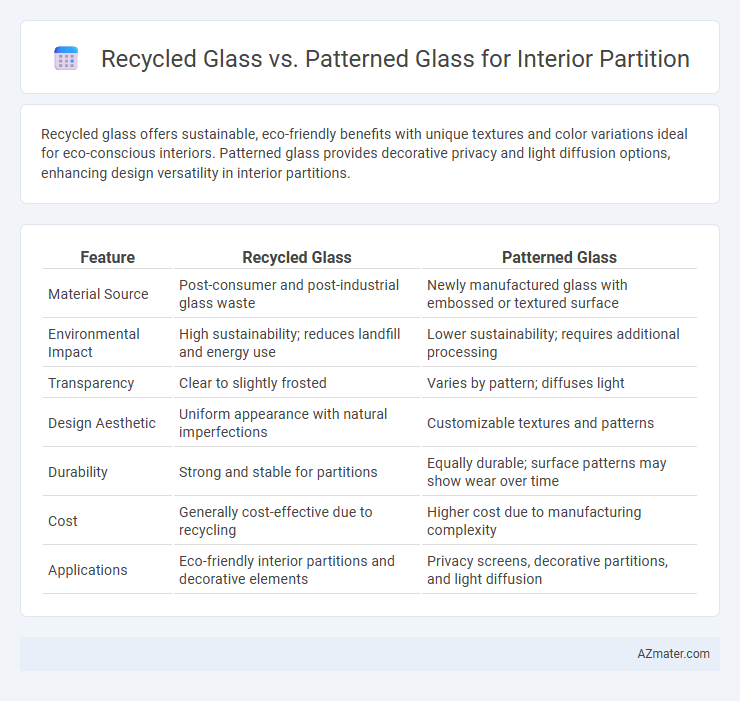Recycled glass offers sustainable, eco-friendly benefits with unique textures and color variations ideal for eco-conscious interiors. Patterned glass provides decorative privacy and light diffusion options, enhancing design versatility in interior partitions.
Table of Comparison
| Feature | Recycled Glass | Patterned Glass |
|---|---|---|
| Material Source | Post-consumer and post-industrial glass waste | Newly manufactured glass with embossed or textured surface |
| Environmental Impact | High sustainability; reduces landfill and energy use | Lower sustainability; requires additional processing |
| Transparency | Clear to slightly frosted | Varies by pattern; diffuses light |
| Design Aesthetic | Uniform appearance with natural imperfections | Customizable textures and patterns |
| Durability | Strong and stable for partitions | Equally durable; surface patterns may show wear over time |
| Cost | Generally cost-effective due to recycling | Higher cost due to manufacturing complexity |
| Applications | Eco-friendly interior partitions and decorative elements | Privacy screens, decorative partitions, and light diffusion |
Introduction to Glass Partitions in Interior Design
Glass partitions are essential elements in modern interior design, offering transparency, light diffusion, and space division. Recycled glass partitions provide an eco-friendly option with sustainable sourcing and unique textures, enhancing aesthetic appeal while reducing environmental impact. Patterned glass partitions deliver decorative privacy and visual interest through etched or embossed designs, balancing functionality with stylistic expression in interior spaces.
What is Recycled Glass?
Recycled glass for interior partitions is made from post-consumer and post-industrial glass waste, melted and reformed into new glass panels, offering sustainable and eco-friendly alternatives. This material provides excellent durability, transparency, and unique aesthetic patterns derived from the original glass fragments, enhancing modern interior designs while reducing environmental impact. Unlike patterned glass, which is manufactured with decorative surface textures, recycled glass emphasizes resource conservation and reduced carbon footprint in architectural applications.
What is Patterned Glass?
Patterned glass is a type of textured glass featuring various designs such as ripple, basketweave, and rain patterns that enhance privacy while allowing light transmission. It is commonly used in interior partitions to create visual interest and obscure visibility without sacrificing brightness. Compared to recycled glass, patterned glass offers a decorative element and consistent surface finish, making it ideal for modern interior designs.
Sustainability and Eco-Friendliness Comparison
Recycled glass partitions significantly reduce environmental impact by lowering raw material extraction and energy consumption compared to patterned glass, which often relies on new glass production processes. The use of post-consumer glass in recycled glass partitions promotes circular economy principles, minimizes landfill waste, and reduces carbon emissions associated with manufacturing. Patterned glass partitions, while aesthetically versatile, typically lack the same sustainability credentials as recycled glass, making recycled glass a superior choice for eco-friendly interior partition solutions.
Aesthetic Appeal: Recycled vs Patterned Glass
Recycled glass partitions showcase a unique, eco-friendly aesthetic with embedded imperfections and flecks that create a natural, textured appearance enhancing sustainability-focused interiors. Patterned glass offers diverse decorative designs such as ribbed, frosted, or etched patterns that deliver precise visual interest and refined privacy control for modern spaces. Choosing between recycled and patterned glass depends on whether the emphasis is on environmental storytelling or tailored, high-design surface detailing.
Durability and Maintenance Considerations
Recycled glass offers high durability due to its resistance to scratches, stains, and impact, making it ideal for long-lasting interior partitions with minimal maintenance. Patterned glass, while aesthetically versatile, may require more frequent cleaning to maintain its textured surfaces and can be more susceptible to damage if not properly handled. Choosing recycled glass enhances sustainability and reduces upkeep costs, whereas patterned glass prioritizes design complexity at a potential expense to durability.
Light Transmission and Privacy Features
Recycled glass for interior partitions offers moderate light transmission with a unique texture that diffuses light while maintaining environmental sustainability. Patterned glass enhances privacy by incorporating intricate surface designs that obscure visibility yet allow ample light to pass through, creating bright and private spaces. Both materials balance transparency and privacy, but patterned glass typically provides superior visual obstruction compared to the more translucent nature of recycled glass.
Cost Analysis: Recycled Glass vs Patterned Glass
Recycled glass typically offers a lower cost option for interior partitions compared to patterned glass, due to its use of waste materials and simpler production processes. Patterned glass, often requiring specialized molds and intricate designs, tends to be more expensive with higher manufacturing and installation costs. Long-term maintenance expenses are generally similar, but the initial investment favors recycled glass for budget-conscious projects.
Applications in Modern Interiors
Recycled glass partitions enhance modern interiors by offering sustainable, eco-friendly solutions with unique, translucent textures that diffuse light while maintaining privacy, ideal for office dividers and residential spaces focusing on green design. Patterned glass partitions provide versatile decorative options with embossed or printed designs that create visual interest and articulation in commercial lobbies, conference rooms, and boutique retail interiors. Both materials contribute to acoustical separation and aesthetic appeal, but recycled glass emphasizes environmental benefits, whereas patterned glass prioritizes customizable style.
Choosing the Right Glass for Your Space
Recycled glass offers eco-friendly benefits with unique color variations that enhance sustainability-focused interiors, while patterned glass provides privacy and decorative texture, ideal for creating distinct zones without sacrificing natural light. Selecting the right glass depends on balancing environmental impact, design aesthetics, and functional needs such as translucency or sound insulation. Tailoring your choice to specific spatial requirements ensures an efficient and visually appealing interior partition solution.

Infographic: Recycled glass vs Patterned glass for Interior partition
 azmater.com
azmater.com